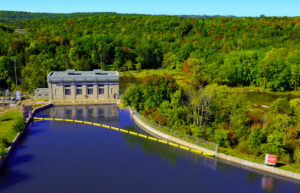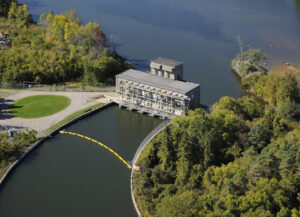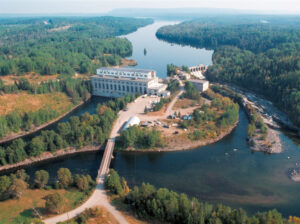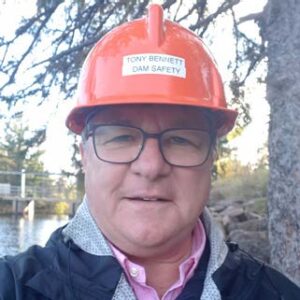Tony Bennett is the longtime director of dam and public safety at Ontario Power Generation (OPG), which generates half the electricity for the Canadian province of Ontario. Over the course of his career at OPG and as a participant in the Canadian Dam Association (CDA) and the International Commission on Large Dams (ICOLD), Mr. Bennett has played a major role in developing public safety standards on the enterprise, national, and international levels. In particular, he played a central role in developing the CDA’s guidelines for public safety around dams. In this interview, he tells Hydro Leader about the significance of public safety around dams and the new techniques that are helping preserve lives in Canada and around the world.
Hydro Leader: Please tell us about your background and how you came to be in your current position.
Tony Bennett: I began my career at Ontario Hydro’s research division before moving to its civil engineering department in the operations branch, which I was fortunate to join just prior to the launch of the company’s dam safety program in 1986. I have held a number of roles since then, always tethered to dams, and since 2002, I have been the director of dam and public safety at OPG. During this time, OPG has supported my participation in a number of professional and industry associations. I have served on the CDA’s board of directors, including serving two terms as president, and remain a member of its dam safety committee and the chair of the working groups on public safety and emergency management, both of which report to the dam safety committee. I also serve as chair of ICOLD’s committee on public safety and participate in a number of other hydro industry forums.

Hydro Leader: Please tell us about OPG as a as an agency.
Tony Bennett: OPG produces more than half the electricity used by the province of Ontario. It is a generator, not a distributor, so it does not have a specific number of customers. Between its various hydroelectric, nuclear, and other generating facilities, OPG has a capacity of 18,876 megawatts (MW). Focusing on hydropower, OPG owns 66 hydropower stations and 241 dams in the province of Ontario. Our hydropower facilities have a capacity of 7,478 MW and produced 32.5 terawatt-hours of power in 2019. Safe operation is a fundamental building block at OPG, and as such, there is a culture that really supports our dam and public safety programs.
Hydro Leader: Please tell us about your role in the CDA’s public safety work and your involvement in developing the CDA’s guidelines for public safety around dams.
Tony Bennett: OPG’s work in public safety around dams began in 2002, when we had an accident at one of our facilities on the Madawaska River. At that time, public safety was outside the realm of OPG’s dam safety program. I was initially tasked with looking for industry guidance and standards regarding public safety around dams. What I found was that there was little guidance out there. Within
North America, there was some high-level guidance that the Federal Energy Regulatory Commission (FERC) had published in 1996 and some guidance that the Bureau of Reclamation had published in 1992. But these did not have the level of detail we felt OPG needed to establish to address the public safety hazards in a formal, managed-system way. As a result, we put together a team and set about developing our own public safety guidance. Over the course of a year, we produced our first set of guidelines for a public safety managed system and standards on topics like safety booms, signage, and audible alerts.

Once we produced that information, dam owners and regulators from virtually the entire world started asking for copies of our guidelines, and in the interest of promoting public safety, we shared it widely. There was a growing interest within Canada in developing national guidance on this topic, so in 2006, the CDA formed a team to produce its own guidelines. Using OPG guidance as the basis and incorporating contributions from Canadian regulators, dam owners, and consultants, the CDA published a draft document in 2007. Owners started to implement the CDA draft guidelines and provided feedback, which eventually led the CDA to finalize the guidelines in 2011 and to produce supporting technical bulletins. Those guidelines closely mirror the OPG guidelines, which have also evolved as we have learned from the practice of others. Associated with the CDA guidelines is a comprehensive, 2‑day training program. OPG staff and others have played a major role in delivering this training to over 400 dam owners, consultants, and regulators in Canada, and they have teamed up with the United States Society on Dams (USSD) to deliver it in the United States. Recently, the CDA entered into an agreement with the Korean National Committee on Large Dams to allow it to translate the Canadian guidelines into Korean and distribute them. OPG trained two representatives from K-water in December 2019 as part of a train-the-trainer initiative so that they can begin the rollout in South Korea, further spreading the influence of the CDA guidance.
Following the release of the Canadian guidelines, ICOLD decided to establish an international committee on public safety around dams, and I was fortunate enough to be nominated as the chair. There are 26 countries that are now members of that committee, through which representatives from around the world share their practices and take what they learn back to their national dam and hydropower associations for implementation. The committee has created a database of over 1,000 incidents and conducted an international survey of practice. We are currently working to produce a set of ICOLD bulletins on public safety. We’ve had significant contributions from Australia, Austria, France, Germany, Japan, New Zealand, Norway, Sweden, the UK, and the United States—with many other countries benefiting from the open forums and workshops that the committee has held.
I am also a member of two U.S. public safety committees, the Association of State Dam Safety Officials, chaired by Paul Schweiger, and the USSD, chaired by Bill Foos. I have been asked to participate in another important initiative under the sponsorship of the Federal Emergency Management Agency (FEMA) to produce U.S. guidelines. FEMA has decided to focus its first set of bulletins on signage. The sponsor from FEMA is James Demby of the agency’s Risk Analysis Division.
Hydro Leader: How are the CDA guidelines different from existing U.S. guidelines, like those of FERC?
Tony Bennett: I think the CDA guidelines provide dam owners with more detailed direction for facility risk assessments than you may find in the FERC or Reclamation guidance documents. They also provide specific examples of good practice relating to signage, safety booms, audible alerts, and other control measures. The main differences are related
to risk assessment methodology. The CDA guidelines provide practitioners with a process to decide on the operating and physical control measures they may want to install to safely manage potential risks associated with dams and hydropower operations. It’s all couched in a managed system to ensure that whatever control measures they choose to install, they have a system in place to maintain them and regularly review their effectiveness. It’s often the case that owners install control measures but don’t implement the right inspection and maintenance practices to ensure that those measures remain in place and are functioning to control the hazards that the public may be exposed to. For example, owners need to continually reassess whether the public interactions around their facilities have changed, and if so, to adjust their control measures to accommodate these changes. The CDA guidelines take that managed-system approach.
Hydro Leader: What were some of the contributions that ICOLD members from around the world made to the ICOLD bulletins on public safety?
Tony Bennett: The French utility Électricité de France has developed excellent guidance on public safety measures and incident reporting. Its guidance requires owners to have what is referred to as a perfect understanding of the river, and it really focuses on carrying out hydraulic assessments that help owners understand the effects that changes in flow have on water levels and velocities downstream, and hence on the safety of the public downstream. In France, a big effort has also been made to establish what are called safety guides, which primarily involves university students working during the summer months to patrol rivers and educate the public about the hazards that may take place there.

In Japan, there are a lot of flashy rivers—the steep terrain and high rainfall events there can create flash floods, which means that dams need to be able to accommodate high inflows through spillway gate operations. The Japanese regulators have established some of the most definitive criteria around the allowable rates of rise of downstream water levels and changes in flow levels. For example, I believe their standard limits operators to a rise of 30 centimeters in 30 minutes in sections of the river downstream from dams.
In Sweden, as in a number of European countries, the public holds a legal right to roam, which is very different from the situation here in North America, where there are generally trespass-to-property rights for owners. In Europe, the owner of a hydropower facility or a piece of land doesn’t have the same right to exclude members of the public, even from areas that might be potentially dangerous. That requires owners to accommodate the possibility of public access in their controls and really work closely with their communities and the public to help them understand the risks associated with dams.
The Norwegians and Australians have both adopted some simplified risk assessment methods, which have good applications for many dam owners and have proven effective at controlling risks to the public.
Hydro Leader: Would you give us some examples of how OPG has changed its approach to operations to account for public safety concerns?
Tony Bennett: I think OPG has done a great job of raising public awareness of the hazards that can occur at dams or because of hydropower operations, and it is committed to sharing the lessons it has learned with other owners, regulators, and consultants in order to reduce risks to the public. OPG is recognized as a leader in delivering public education and service announcements related to public safety. The company has supported my colleagues and me in delivering that training to people across North America and in participating in forums such as the CDA and ICOLD. We have definitely learned from others and incorporated those lessons into our program, but we also want to share and make sure that other owners improve their practice.
I think it’s fair to say that we’ve always tried to stay out in front of our public safety issues. As an example, at three of our locations at which conventional measures such as safety booms have proven challenging to maintain, we’ve installed radar systems to detect when the public may be approaching our facilities. Safety booms can be difficult to install in locations with high-flow conditions or heavy ice loads. As far as I know, radar detection systems of this type have not been installed elsewhere. One of these locations is above Niagara Falls. Through the international control works, OPG manages flow over the falls and diversions to OPG and the New York Power Authority’s plants downstream. The area upstream of the dam has become a popular spot for jet skiers and fishing boats. Our new detection system has assisted us in deterring the public from interacting in these dangerous waters and in keeping safe people whose vessels have become disabled in the high-flow conditions.
OPG has also supported the international database on incidents and fatalities. One interesting observation is that the data show a noticeable decrease in fatalities—from an average of six fatalities a year to one or two—since the CDA guidelines were published and training began in October 2011. I realize that the drop from six to one or two doesn’t sound like a lot, but if you’re one of those people or are related to one of them, it’s an awful lot. We at OPG are proud to be part of that change. I think it demonstrates that that these guidelines are effective and that owners are taking public safety seriously.
Tony Bennett is the director of public safety at Ontario Power Generation. He can be contacted at tony.bennett@opg.com.

